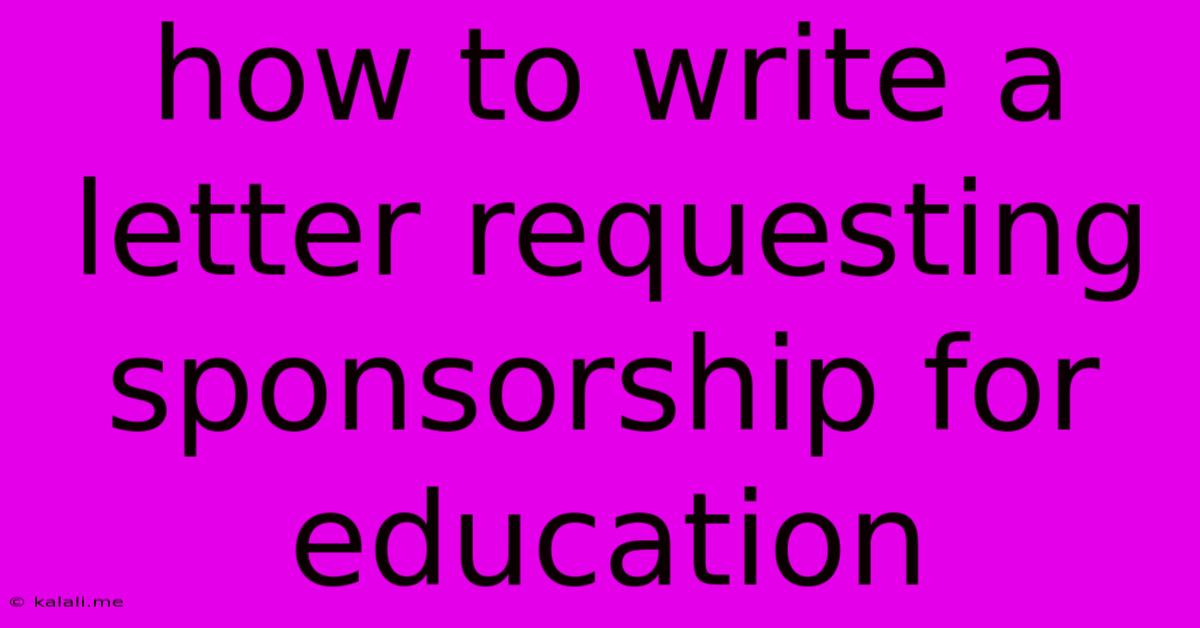How To Write A Letter Requesting Sponsorship For Education
Kalali
Jun 14, 2025 · 4 min read

Table of Contents
How to Write a Compelling Sponsorship Letter for Education
Securing educational sponsorship can significantly ease the financial burden of pursuing your studies. However, crafting a compelling sponsorship letter that resonates with potential sponsors requires careful planning and execution. This guide provides a step-by-step approach to writing a successful sponsorship request letter for your education. This includes outlining key components, offering sample phrases, and providing tips to maximize your chances of securing the funding you need.
Understanding Your Audience and Tailoring Your Letter:
Before you begin writing, consider your target audience. Are you writing to a specific organization, a foundation, or an individual? Research their mission, values, and past sponsorship activities to tailor your letter accordingly. Demonstrate a genuine understanding of their priorities and explain how your educational goals align with their interests. This personalization significantly increases your chances of approval.
Key Components of a Successful Sponsorship Letter:
A strong sponsorship letter should include the following elements:
1. Introduction:
- Start with a compelling hook: Briefly introduce yourself and your educational aspirations. Avoid generic openings. Instead, immediately highlight your unique qualities and potential.
- State your purpose clearly: Explicitly state that you are requesting sponsorship for your education.
- Mention the specific program: Clearly name the educational program you're applying for, including the institution, degree, and duration.
Example: "I am writing to request sponsorship for my pursuit of a Master's degree in Computer Science at the prestigious Massachusetts Institute of Technology (MIT), a program I am thrilled to have been accepted into. This two-year program will equip me with..."
2. Background and Motivation:
- Provide a concise background: Briefly explain your educational history, academic achievements, and any relevant work experience.
- Highlight your motivation: Explain your passion for your chosen field and why you are pursuing this specific program.
- Showcase your potential: Emphasize your future goals and how your education will contribute to your career aspirations and society.
Example: "Throughout my undergraduate studies, I consistently achieved Dean's List honors, showcasing my dedication to academic excellence. My passion for sustainable energy technology led me to..."
3. Financial Needs and Budget:
- Provide a detailed budget: Clearly outline the total cost of your education, including tuition fees, accommodation, books, and other living expenses.
- Specify the amount of sponsorship requested: Be clear about how much funding you need and what portion you plan to cover yourself.
- Explain how the funds will be used: Provide a breakdown of how the sponsorship will be allocated to different aspects of your education.
Example: "The estimated total cost of my education is $60,000. I have secured $15,000 through personal savings and scholarships; therefore, I am humbly requesting sponsorship of $45,000 to cover the remaining expenses."
4. Expected Outcomes and Return on Investment (ROI):
- Highlight your future contributions: Articulate how your education will benefit society and contribute to your chosen field.
- Demonstrate your commitment: Express your commitment to your studies and your future career goals.
- Show the potential ROI for the sponsor: If possible, highlight how your success will indirectly benefit the sponsor (e.g., through future employment, community involvement, or positive publicity).
Example: "Upon completion of this program, I plan to apply my expertise in sustainable energy to contribute to the development of renewable energy solutions in developing countries. This work aligns with..."
5. Closing and Contact Information:
- Express your gratitude: Thank the sponsor for considering your request.
- Reiterate your commitment: Reiterate your dedication to your studies and your future goals.
- Provide contact information: Include your phone number, email address, and any other relevant contact details.
Example: "Thank you for considering my application. I am confident that with your support, I can achieve my educational and career goals. I welcome the opportunity to discuss my application further and answer any questions you may have. You can reach me at..."
Additional Tips for a Successful Sponsorship Letter:
- Keep it concise and focused: Avoid unnecessary details or overly lengthy explanations.
- Proofread carefully: Ensure your letter is free of grammatical errors and typos.
- Maintain a professional tone: Use formal language and maintain a respectful tone throughout the letter.
- Submit your letter with supporting documents: Include your academic transcripts, acceptance letter, and any other relevant documents that support your request.
By following these guidelines, you can craft a compelling sponsorship letter that effectively communicates your needs, aspirations, and potential, increasing your chances of securing the financial support you need to achieve your educational goals. Remember, sincerity and a clear articulation of your vision are key elements in a successful sponsorship application.
Latest Posts
Latest Posts
-
What Is The Difference Between Observations And Inferences
Jun 15, 2025
-
Which Digestive Enzyme Hydrolyzes Protein In The Stomach
Jun 15, 2025
-
Which Of The Following Statements Best Describes Scientific Research
Jun 15, 2025
-
Applications Of Series And Parallel Circuits
Jun 15, 2025
-
35 Is What Percent Of 105
Jun 15, 2025
Related Post
Thank you for visiting our website which covers about How To Write A Letter Requesting Sponsorship For Education . We hope the information provided has been useful to you. Feel free to contact us if you have any questions or need further assistance. See you next time and don't miss to bookmark.